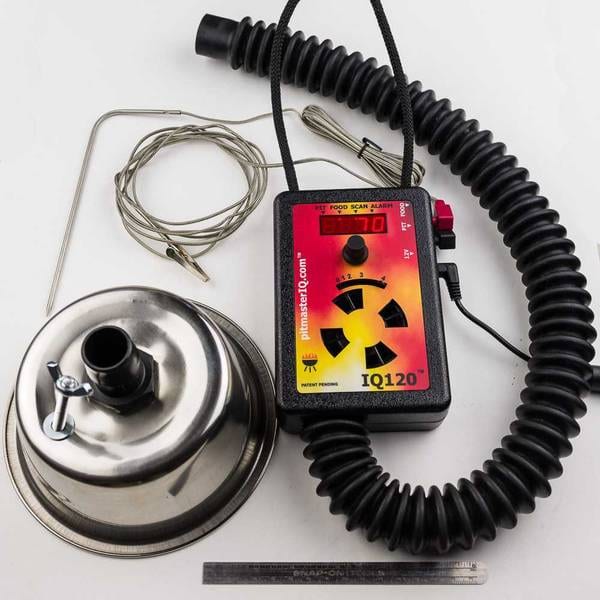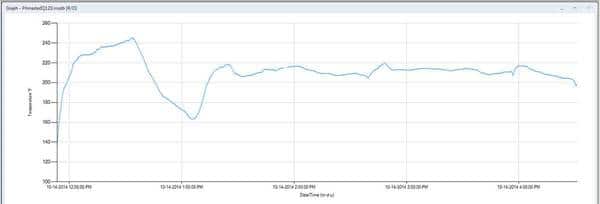YOU ARE HERE >> AmazingRibs » Ratings & Reviews » Pitmaster IQ120 Review
Pitmaster IQ120 Review
All of our reviews are done independently by our team of testers and are in no way influenced by advertising or other monetary compensation from manufacturers. Click here to learn more about our unbiased product review process.
Published On: 10/20/2014 Last Modified: 11/4/2025

The Pitmaster IQ120 is a straightforward temperature controller for charcoal grills and smokers. The controller and the fan are integrated into one plastic housing with air suppled to the cooker via a corrugated rubber hose and manifold that mounts on the cooker’s air vent. A separate probe is clipped to the cooking grate and supplies temperature feedback to the controller. There is one additional probe for monitoring food temperature.
Pitmaster IQ120 Features
Temperature Controls
The Pitmaster IQ120 uses a knob that can be pressed (clicked) and rotated to set the temperature, alarms, and operating mode. There is an LED to indicate the actual and set temperature and alarm status. A rotating icon indicates when the fan is running. Once the target pit temperature is set, you can specify a range outside of which an alarm will annunciate. For example, if you set a target of 225° and a range of 25°, the alarm will sound if the temp drops below 200º or goes above 250°. There is a second alarm that will sound when the food reaches a user-settable temperature.
Temperature can be set to Fahrenheit or Celsius scales. The volume of the alarm can be controlled, too, as can the brightness of the LED readout. The controller can auto-detect if the lid has been raised, and will delay feeding more air so that the temperature does not overshoot the set value. This feature can be turned on or off.
There is a feature that will allow you to set a timer that will change the pit set temperature when it times out. You can also program it to change the pit temperature when the food set temperature is reached. There are several interactive settings that I found a bit confusing. The names given to the various settings make using them a little counter-intuitive, at least for me. The confusion would probably resolve after a few sessions with the owner’s manual.

Damper Control
There is a damper control that allows the user to throttle back the airflow if the temperature fluctuations are excessive. The instructions state that some manipulation of the damper and the cooker vents might be required to find the right combination of airflow to yield a stable temperature. For this test, the damper was half open. The air is routed through the supplied hose into a bell-shaped manifold that mounts over one of the lower vents. This is held snugly against the cooker using a supplied screw and nut, and is easily fitted or removed. (The screw that secures the manifold is longer than it needs to be, and interfered slightly with centering the charcoal ring, but this is a very minor issue.)
Our Pitmaster IQ120 Tests
Test Procedure: This product was tested on an 18.5″ Weber Smokey Mountain. The air manifold was inserted over one of the lower vents, and the others were closed. I loaded 2 lbs. of Kingsford Competition Briquets into the cooker, and lit 1 lb. of the same charcoal in a chimney, and poured it on the unlit coals already in the smoker. The water bucket was about 2/3 full, and there was no food in the cooker. The temperature probe was clipped to the center of the top cooking grate. Another temperature probe was mounted close to the sensor and plugged into a ThermoWorks BlueTherm Duo that was monitored on my computer for temperature recording purposes. The set temperature was 225ºF, consistent with smoking practices.
Temperature Test Results
The outside air temperature was around 85°F. Winds were calm. Measurements began shortly after the smoker was closed up. The charcoal burned for a little over five hours before the blower began to run full-time, signaling that the fuel was nearly exhausted. At that point, I terminated the test. The captured data from the ThermoWorks sensor was plotted, and the raw data was exported to Excel so that I could calculate temperature maxima, minima, average and standard deviation. The last value gives a measure of how consistent the temperature remained. If the temperature was dead constant, the standard deviation would be zero. The larger the swings in temperature, the higher the standard deviation would be. The values for this test are:
Minimum temperature: 214°F
Maximum temperature: 233°F
Average temperature: 225°F
Standard deviation: 3.51°F

I set the temperature control to 225°F, and took whatever temperature the unit produced. As you can see on the graph, the controller hovered around 212° when set to 225°. However, testing the probes showed that they were very accurate, so the graph reading is probably due to different probe placements.
Slight Issues
The accompanying graph shows some temperature overshoot then a big dip at the beginning of the test. This was caused by the top cover of the Weber being ajar and letting in too much air. The dip occurred when I put the lid on properly. There are also a couple of blips in the temperature data that occurred when I opened the door to jostle the charcoal to remove ash accumulation. Ignore that data. Overall, the controller kept the temperature within a range of +/- 8°F. This is fine for cooking, although other controllers did a slightly better job of temperature regulation. You can click on the temperature vs. time graph below to see a larger version.
The instruction manual is reasonably complete but a little confusing in places. A picture of the controller with arrows indentifying the various controls would have been helpful. The main components – the controller/blower, power supply come with a 180-day warranty. The probes are warranted to work out of the box, but are no longer covered once used. There are the usual caveats about probe care and getting them wet or kinked. The manufacturer’s contact information, including address, website, e-mail and telephone numbers are found in the owner’s manual.
Our Review
We give the Pitmaster IQ120 unit a Gold medal for its low price, useful features, straightforward operation and good performance. At only $200, it’s relatively inexpensive, so it represents a good value as a basic thermostatic controller.
Click the buttons below to search our complete database of reviews:
Product Information:
-
Thermometer Function:Thermostats/Temperature Controllers
-
Item Price :199.95
*Price Subject To Change -
Where to buy (buying from this supplier supports this website):
-
Probe:Food: length: 5.75" (14.6cm), diameter: 0.128" (3.2mm), cable: 76" (1.9m) Pit: diameter: 0.126" (3.2mm), cable:82" (2.1m)
-
Battery Type:n/a
-
Battery Life:n/a
-
Safe Operating Range:0 to 140°F (-18 to 60°C)
-
Min & Max Temp:150 to 400°F (66 to 204°C)
-
Display Precision:1º
-
Actual Temp at 130 Degrees:Food=131, Pit=131
-
Actual Temp at 225 Degrees:Food=225, Pit=225
-
Actual Temp at 325 Degrees:Food=325, Pit=326
-
Speed from 32 to 212 Degrees:n/a
-
Numbers Display Size:0.43" (11mm)
-
Water Resistance Rating:Not water resistant
-
Weight:12 oz (340g) (controller box)
-
C/F Switch:Built in CF switch
-
Backlight:No Backlight
-
Color Options:Black
-
Thermometer Sensor:Thermocouple
-
Logging:No
-
Included:Controller, hose, flange, AC adapter, pit probe, food probe, tape, instructions
-
Alarms:audible and visible, adjustable
Related reviews
-
Bill McGrath, AmazingRibs.com Chief Thermometer Reviewer - Bill McGrath is AmazingRibs.com's Thermometer Maven. He has sophisticated equipment, an electrical engineering degree from Cornell University, and an MBA (almost) from UC Berkeley.
Up Your BBQ IQ By Joining The Pitmaster Club

Sign up for a free trial of the AmazingRibs.com Pitmaster Club and experience everything that the world’s largest membership-based BBQ and grilling community has to offer!

High quality websites are expensive to run. If you help us, we’ll pay you back bigtime with an ad-free experience and a lot of freebies!
Millions come to AmazingRibs.com every month for high quality tested recipes, tips on technique, science, mythbusting, product reviews, and inspiration. But it is expensive to run a website with more than 2,000 pages and we don’t have a big corporate partner to subsidize us.
Our most important source of sustenance is people who join our Pitmaster Club. But please don’t think of it as a donation. Members get MANY great benefits. We block all third-party ads, we give members free ebooks, magazines, interviews, webinars, more recipes, a monthly sweepstakes with prizes worth up to $2,000, discounts on products, and best of all a community of like-minded cooks free of flame wars. Click below to see all the benefits, take a free 30 day trial, and help keep this site alive.
Post comments and questions below
1) Please try the search box at the top of every page before you ask for help.
2) Try to post your question to the appropriate page.
3) Tell us everything we need to know to help such as the type of cooker and thermometer. Dial thermometers are often off by as much as 50°F so if you are not using a good digital thermometer we probably can’t help you with time and temp questions. Please read this article about thermometers.
4) If you are a member of the Pitmaster Club, your comments login is probably different.
5) Posts with links in them may not appear immediately.
Moderators